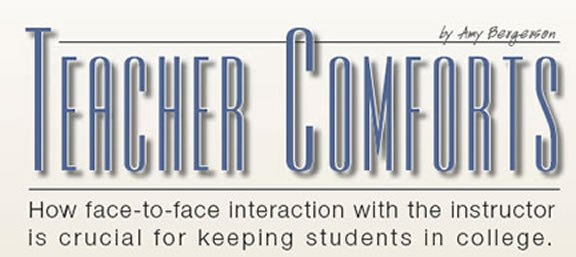
Vol. 15 No. 3 |
Winter 2005-06 |

 I
was unprepared for Amherst’s rigorous academic program. My grades
were low, and it was readily apparent to any observant instructor that
I was struggling to keep up. One afternoon, after a session of “Race,
Culture, and Society,” Professor Mary Catherine Bateson stopped
me as I left our seminar room, and asked a simple question: “Are
you OK?” she said, and then offered to help me in any way she could
in my adjustment to Amherst. After that, I made every effort to read everything
assigned for her class. And for my “Introduction to Philosophy”
class, Professor William Kennick told me that mine was the first failing
grade he’d given on a paper in his nearly 50 years of teaching.
Yet he, too, offered to spend the time necessary to help me pass his course.
Four years later, I received my bachelor’s degree with honors.
I
was unprepared for Amherst’s rigorous academic program. My grades
were low, and it was readily apparent to any observant instructor that
I was struggling to keep up. One afternoon, after a session of “Race,
Culture, and Society,” Professor Mary Catherine Bateson stopped
me as I left our seminar room, and asked a simple question: “Are
you OK?” she said, and then offered to help me in any way she could
in my adjustment to Amherst. After that, I made every effort to read everything
assigned for her class. And for my “Introduction to Philosophy”
class, Professor William Kennick told me that mine was the first failing
grade he’d given on a paper in his nearly 50 years of teaching.
Yet he, too, offered to spend the time necessary to help me pass his course.
Four years later, I received my bachelor’s degree with honors.
The point is that the personal interactions I had with these two professors saved my academic career. These connections with faculty who reached out to help a struggling student were the first steps on a path that led me to the Department of Educational Leadership and Policy here at the University of Utah. As an assistant professor, I teach and work with master’s and doctoral students who come to study here for many reasons. Some want to learn more about a career they love. Others want an advanced degree so they can earn more money. But most of our grad students want to make a difference in students’ lives. They want to pass on some of their knowledge and a bit of themselves, and usher students through the educational ropes. They want to do for their students what professors Bateson and Kennick did for me. And I know from my student experiences as well as my work at the University that connecting with faculty is the essential ingredient for student retention.
For years, it has been understood that student engagement in campus life contributes to persistence and learning. Developments in the areas of residential living, student activities, and student life and leadership are all important efforts to create engaging experiences for students, but those are only a piece of the equation.
Recently, some researchers have suggested that we look into what happens—or doesn’t happen—in classrooms as part of campus involvement, not only for increasing student learning, but also for encouraging students to stay in college. The role of an engaged instructor, something more than a warm body in the classroom or a video screen chirping assignments, cannot be understated.
Researcher V. Tinto argues that a caring, involved teacher will “shape the nature of classroom communities and the manner in which students become involved in learning in and beyond those communities.” We’re finding that student-faculty contact and active learning are among the factors in higher education environments that promote learning and personal development in students. Perhaps we have known this intuitively for some time, and the data now backs that up. I have found, as have many other researchers in the field, that there is simply no substitute for a teacher who takes an active interest in her students, and students who have some degree of personal contact with the instructor are more likely to remain in school.
Which brings us to the thorny question of “distance learning” and educational technology. How does that fit in with keeping students engaged? Certainly, incorporating technology into the classroom enhances the ability of faculty to reach many students. The use of e-mail, for example, allows faculty to continue discussions with dispersed students outside of the classroom, and allows students who hesitate to participate during class to add their ideas to group conversation. It is clear that the use of technology to enhance classroom instruction contributes to learning, but our understanding of the impact of students taking classes in exclusively technology-based formats is less definite. While distance and computer learning environments benefit students who otherwise might not attend college, the wealth of evidence supporting the positive impact of student-faculty interactions in retention, learning, and personal development demonstrates that students who come to campus and interact with both peers and faculty have the greatest chance for academic success.
The old-fashioned art of conversation trumps technology every time. And an instructor who is passionate—not only about her realm of expertise or research, but also about the well-being of her students—can make the difference when a college student is struggling. It’s one more powerful tool that universities and colleges can use to retain students, and one worth encouraging.
—Amy Bergerson is assistant professor in the Department of
Educational Leadership and Policy and a leading expert in student retention.